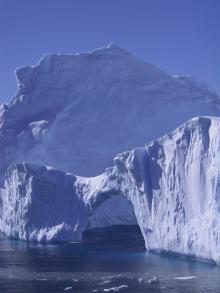
Past Antarctic Ice Sheet Development Linked to Ocean Temperatures and Carbon Dioxide
New research published in the September 17 issue of the journal Science sheds light on the evolution of Earth's climate system by identifying changes in temperature, ocean circulation, and global carbon cycling associated with the rapid growth of Antarctic ice sheets approximately 14 million years ago.
By studying chemical changes in deep sea sediments, scientists at the University of California, Santa Barbara discovered that high-latitude Southern Ocean cooling helped to trigger this major expansion of Antarctic ice sheets, which have since become a permanent feature of the global climate system. These results document ice sheet history and supply crucial insight into the dynamics of the global climate system.
Scientists have long recognized that the Southern Ocean and the development of Antarctic ice sheets play a major role in the evolution of Earth's present climate system. Only now have researchers been able to obtain a clearer picture of the relationship between high-latitude temperatures, global carbon cycling and the size of Antarctic ice sheets.
Southern Ocean temperature data exhibits a rapid 7 degree cooling of surface waters around 14 million years ago and suggests a strengthening of the Antarctic Circumpolar Current in response to changes in the geometry of Earth's orbits. As a result, Antarctica became increasingly isolated from tropical heat and moisture sources. Records of Antarctic ice volume indicate that following this cooling ice sheets expanded rapidly to near present-day size, which suggests that changes in the Southern Ocean directly influence the size of the Antarctic ice sheet.
UCSB researchers speculate that the climate system responded quickly to orbital variations because of generally low atmospheric carbon dioxide levels and plate tectonic changes north and south of Australia.
"Our study indicates that the sensitivity of Earth's climate system can shift rapidly when climate boundary conditions, such as atmospheric greenhouse gas levels or the configuration of the continents, change," said Amelia Shevenell, the lead author of the Science study and a Ph.D. candidate at UCSB.
"Our results suggest that scientifically it is somewhat incidental whether these boundary conditions are altered via natural or human-induced processes," she said. "If the boundary conditions change, we should expect Earth's climate system to respond."
Shevenell and co-authors Jim Kennett and David Lea, both professors of geological sciences at UCSB, developed the records of Southern Ocean sea surface temperature change, Antarctic ice volume, and global carbon cycling by measuring chemical changes in the fossilized skeletal remains of marine plankton contained in deep-sea sediments. Shevenell and Kennett collected these sediments south of Tasmania when they sailed as scientists on the Ocean Drilling Program's drill ship, the JOIDES Resolution.
This research was supported by the National Science Foundation and Joint Oceanographic Institutes.
For additional information, visit these web sites:
Jim Kennett Site http://www.geol.ucsb.edu/faculty/kennett/
David Lea Site http://www.geol.ucsb.edu/faculty/lea/
Geological Sciences Dept http://www.geol.ucsb.edu/
National Science Foundation http://www.nsf.gov/
Science Magazine http://www.sciencemag.org/
Jim Kennett Site
David Lea Site
Geological Sciences Department



